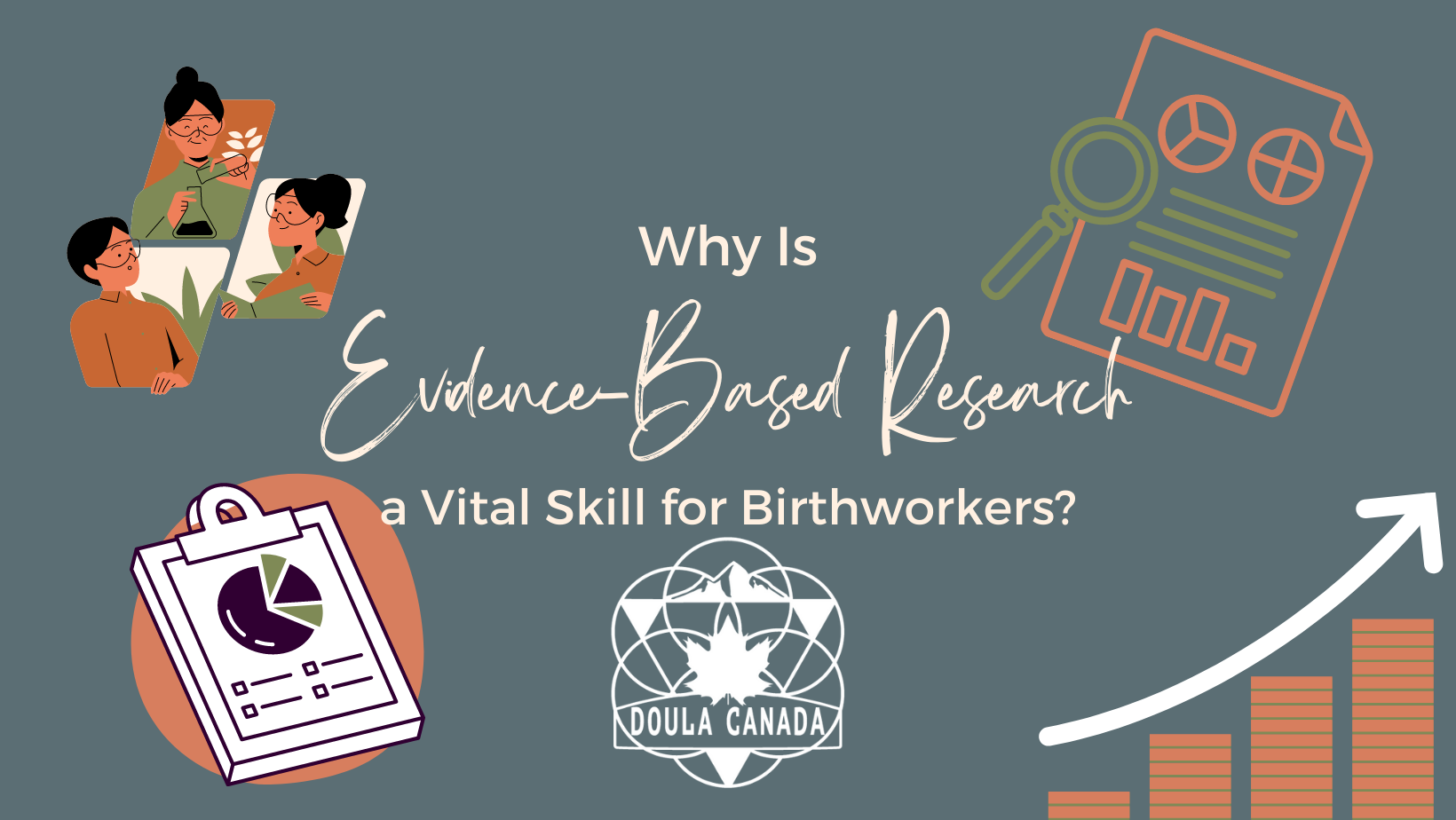[vc_row][vc_column][vc_column_text css=”.vc_custom_1645285741139{margin-bottom: 0px !important;}”]
Why Is Evidence-Based Research a Vital Skill for Birthworkers?
[/vc_column_text][vc_separator color=”white”][/vc_column][/vc_row][vc_row][vc_column][vc_column_text css=”.vc_custom_1645285895328{margin-bottom: 0px !important;}”]The term “evidence-based” gets used a lot more than it gets explained. “Evidence-Based medicine” is a movement within health care practice that started about 30 years ago. It is a shift in approach to relying on the best available research data to support clinical decision making regarding testing, diagnosis and treatment. It differs from the previous practice in medicine and other health professions where teaching was largely apprenticeship-based, and physicians relied on their personal clinical experience to determine patient care plans (Masic et. al., 2008).[/vc_column_text][vc_column_text css=”.vc_custom_1645285507272{margin-bottom: 0px !important;}”]Relying upon scientific evidence to make decisions has the potential to improve patient outcomes because decisions are made based on clinical data that clearly show what happened most of the time when certain choices were made or methods used. It all sounds logical and straightforward, but evidence-based care is actually more challenging to implement than it sounds and it is not without controversy. In reality, evidence-based care happens very inconsistently (Lehane et. al., 2019).[/vc_column_text][vc_column_text css=”.vc_custom_1645286010844{margin-bottom: 0px !important;}”]This is where doulas have the potential to help. There is no organized system whereby new research makes it into the hands of healthcare professionals. There can be quite a lag between new, credible research being published and health care professionals updating their practice to align with it (Lehane et. al. 2019, Soliday and Smith, 2017). It takes physicians an average of 17 years to change their practice in accordance with new research. [/vc_column_text][vc_column_text css=”.vc_custom_1645285541602{margin-bottom: 0px !important;}”]Additionally, while unintentional, an evidence-based approach can be in contradiction with a patient-centred, individualized approach to care. The standard 15 minute medical appointment does not make it feasible to conduct research for each individual. This means that even providers who are staying apprised of new research developments may provide “one-size fits all” care due to resource constraints.[/vc_column_text][vc_column_text css=”.vc_custom_1645285557316{margin-bottom: 0px !important;}”]Institutional policies and legislations are often even slower to change with new evidence. For example, while evidence has been available for quite some time that routine antibiotic eye ointment for newborns is unnecessary, this is still a hospital requirement in many jurisdictions. If providers feel pressured by institutional policy, these interventions are often framed as requirements. From the provider’s perspective that is true, however the patient always has the right to refuse treatment. Often, legislation and institutional policies only change when concerned patients and healthcare providers call for change (Soliday and Smith, 2017).[/vc_column_text][vc_column_text css=”.vc_custom_1645285573376{margin-bottom: 0px !important;}”]Doulas who are skilled at evidence-based research can support clients to gather and interpret credible scientific information that is specific to their unique needs and circumstances. Clients equipped with this information are well-positioned to self-advocate by speaking a language the provider understands (Soliday and Smith, 2017). I know from lived experience as a Queer, Black woman that being an informed and educated healthcare consumer makes for much more empowering healthcare experiences.[/vc_column_text][vc_separator color=”white”][/vc_column][/vc_row][vc_row][vc_column][vc_column_text css=”.vc_custom_1645286312153{margin-bottom: 0px !important;}”]On February 24 at 6 PM EST, I am hosting a webinar on conducting evidence-based research in birthwork. The webinar will focus on preparing a strong literature review for perinatal informational support. A literature review refers to the process of compiling and synthesizing all of the current and relevant scientific information that is available on a topic. Analysis involves assessing the quality of each source and summarizing the complete body of literature. [/vc_column_text][vc_column_text css=”.vc_custom_1645285639985{margin-bottom: 0px !important;}”]During this session, we will discuss what exactly is “evidence”. We’ll go over the different types of health research evidence that exists, as well as how to determine which sources are credible, and how different sources can vary in quality. Participants will also learn about the different types of bias that can crop up in how we search for and analyze information, as well as how to spot and reduce bias in their own research.[/vc_column_text][vc_column_text css=”.vc_custom_1645285655944{margin-bottom: 0px !important;}”]Using real scenarios provided by DTC members and webinar attendees, we’ll walk through how to turn a client concern into an unbiased research question and find a solid answer that supports your client to make informed decisions and have confident discussions with their healthcare team. [/vc_column_text][vc_column_text css=”.vc_custom_1645285674079{margin-bottom: 0px !important;}”]My approach to research draws from a mix of my graduate education in health services research, professional experiences in policy and healthcare research and my lived experiences as a Queer, racialized healthcare user. I am very excited to share knowledge and grow with those who can attend![/vc_column_text][vc_btn title=”Register here for our RESEARCH SKILLS FOR BIRTH WORKERS Webinar” color=”mulled-wine” align=”center” link=”url:https%3A%2F%2Fstefanie-techops.wisdmlabs.net%2Ftraining%2Fresearch-skills-for-birth-workers-webinar%2F|||”][/vc_column][/vc_row][vc_row][vc_column][vc_column_text css=”.vc_custom_1645285701619{margin-bottom: 0px !important;}”]Citations
Lehane, E., Leahy-Warren, P., O’Riordan, C., Savage, E., Drennan, J., O’Tuathaigh, C., O’Connor, M., Corrigan, M., Burke, F., Hayes, M., Lynch, H., Sahm, L., Heffernan, E., O’Keeffe, E., Blake, C., Horgan, F., & Hegarty, J. (2019). Evidence-based practice education for healthcare professions: An expert view. BMJ Evidence-Based Medicine, 24(3), 103–108. https://doi.org/10.1136/bmjebm-2018-111019
Masic, I., Miokovic, M., & Muhamedagic, B. (2008). Evidence Based Medicine – New Approaches and Challenges. Acta Informatica Medica, 16(4), 219–225. https://doi.org/10.5455/aim.2008.16.219-225
Soliday, E., & Smith, S. R. (2017). Teaching University Students About Evidence-Based Perinatal Care: Effects on Learning and Future Care Preferences. The Journal of Perinatal Education, 26(3), 144–153. https://doi.org/10.1891/1058-1243.26.3.144[/vc_column_text][/vc_column][/vc_row]


 Keira brings a wealth of experience to the Online Community Moderator role. She is a Queer, Black woman with a twenty-year track record in Equity, Diversity, and Inclusion (EDI) education, projects, and community building initiatives.[/vc_column_text][/vc_column][/vc_row]
Keira brings a wealth of experience to the Online Community Moderator role. She is a Queer, Black woman with a twenty-year track record in Equity, Diversity, and Inclusion (EDI) education, projects, and community building initiatives.[/vc_column_text][/vc_column][/vc_row]
